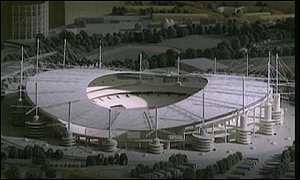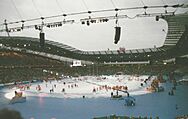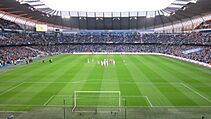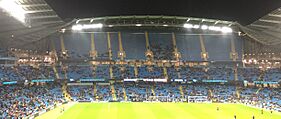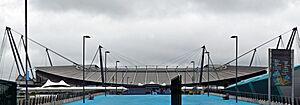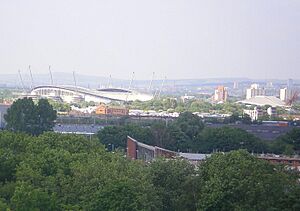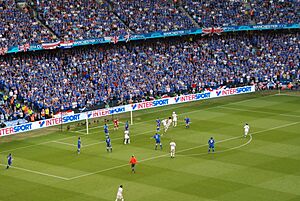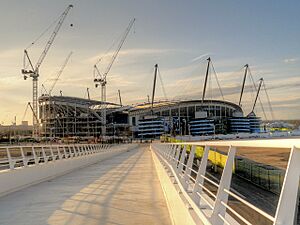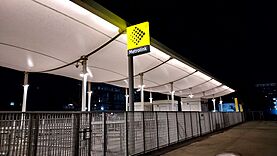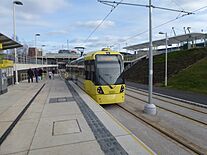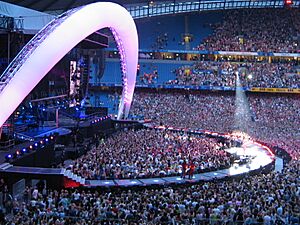City of Manchester Stadium facts for kids
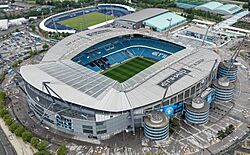
City of Manchester Stadium (2023)
|
|
| Full name | City of Manchester Stadium |
|---|---|
| Address | Ashton New Road |
| Location | Etihad Campus Manchester, England M11 3FF |
| Public transit | |
| Owner | Manchester City Council |
| Operator | Manchester City |
| Executive suites | 70 |
| Capacity | 52,900 (Temporary) – Domestic football 60,000 – Music concerts 41,000 (2002 Commonwealth Games) |
| Record attendance | 54,693 (Manchester City vs Leicester City, 6 Feb 2016) |
| Field size | 105 by 68 metres (114.8 yd × 74.4 yd) |
| Surface | Desso GrassMaster |
| Construction | |
| Broke ground | December 12, 1999 |
| Opened | 25 July 2002 (as athletics stadium) 10 August 2003 (as football stadium) |
| Renovated | 2002–2003 (conversion) |
| Expanded | 2014–2015 (47,400 to 55,100 seats) 2023–2026 (55,100 to 61,470 seats) |
| Construction cost | £112 million (athletics stadium) £22 million (football conversion) £20 million (football fit-out) |
| Architect | Arup (stadium design) KSS Design Group (interior fitout) Populous (stadium expansion) |
| Structural engineer | Arup |
| General contractor | Laing Construction Ltd. (initial construction), Laing O'Rourke (stadium conversion & later expansion) |
| Main contractors | Watson Steel Ltd (initial steelwork construction) |
| Tenants | |
Manchester City (2003–present)
|
|
| Website | |
| Etihad Stadium | |
The Etihad Stadium is a famous sports ground in Manchester, England. It is the home stadium for the Premier League football club Manchester City. The stadium can hold about 53,600 football fans. This makes it one of the largest football stadiums in England.
The stadium was first built for the 2002 Commonwealth Games. Since then, it has hosted many big events. These include the 2008 UEFA Cup final, international football matches for England, and rugby league games. It has also held boxing matches and huge summer music concerts.
After the Commonwealth Games in 2002, the stadium was changed. It went from an athletics arena to a football stadium. This change cost the city council £22 million and Manchester City Football Club £20 million. Manchester City moved into the stadium in 2003 from their old ground, Maine Road.
The stadium was built by Laing Construction and designed by Arup. Its design is special, with a roof held up by cables and twelve tall masts. This design has won awards for being innovative and well-planned. In 2015, the stadium grew bigger. A new section was added to the South Stand, increasing the number of seats. More expansion work started in 2023 and is expected to finish by late 2026. This will make the stadium even larger, with about 61,000 seats.
Contents
History of the Stadium
How the Stadium Started
Manchester first planned a new stadium before 1989. This was part of the city's try to host the 1996 Summer Olympics. They wanted an 80,000-seat stadium. However, Atlanta won those Games. Later, Manchester tried for the 2000 Summer Olympics. This time, they focused on a different site, east of the city center. This area was old, unused land.
Manchester did not win the 2000 Olympics either. But they kept trying. They then bid to host the 2002 Commonwealth Games with a smaller stadium plan. This time, they were successful! The stadium was also considered to become the new national stadium for England. However, the money went to rebuild Wembley Stadium instead.
Some people who loved athletics were sad when the stadium became a football ground. They thought the UK needed a big stadium for track and field events. But the stadium designers believed that football and athletics tracks often do not mix well. They wanted the stadium to be used often and be financially stable. So, it was decided to convert it for football.
The 2002 Commonwealth Games
Construction of the stadium began in January 2000. It cost about £112 million to build. Most of this money came from Sport England and Manchester City Council. For the Commonwealth Games, the stadium had seats for 38,000 people. This was later increased to 41,000 with extra temporary seats.
The first public event was the opening ceremony of the 2002 Commonwealth Games. This happened on July 25, 2002. Queen Elizabeth II officially opened the Games. For ten days, the stadium hosted track and field events and rugby sevens matches. Many new records were set there. The 2002 Games were the biggest multi-sport event in the UK at that time.
Changing to a Football Stadium
The stadium during the Commonwealth Games.
After conversion, the pitch was lowered to add more seats.
A third tier was added to the South Stand in 2015.
After the Games, the stadium was changed for football. The athletics track was removed. The ground level was lowered to add more seats. Temporary stands were taken down and replaced with permanent ones. This work took almost a year. It added 23,000 permanent seats, making the total capacity about 48,000.
Manchester City Football Club moved in for the 2003–04 season. The total cost of this change was over £40 million. The city council paid for the track and seating changes. The football club paid for new bars, restaurants, and VIP areas.
Stadium Expansion
Manchester City Football Club leases the stadium from Manchester City Council. The club pays for all running costs and gets all the money from stadium users. In 2010, Manchester City changed its lease agreement. They got the right to name the stadium. In return, they agreed to pay the City Council £3 million each year.
Because the club sold out its season tickets every year, they decided to expand the stadium. In 2014–15, the South Stand got a third tier of seats. This increased the stadium's capacity to about 55,000.
Future Plans
There are plans for more expansion. The North Stand will also get a third tier of seats. This will make the stadium's total seating capacity around 62,000. This would make it the fourth-largest club ground in England.
A £300 million plan for the North Stand was approved in April 2023. It includes a new hotel and a covered fan park. This will increase the capacity to 61,474 seats. This work is expected to be finished by the end of 2026.
Stadium Design
Manchester City Council wanted a special building. It needed to be a symbol for the area's renewal. The stadium was designed to feel like an exciting arena for football. The pitch is six meters below ground level, like old Roman arenas. The design has many cool details. These include the cigar-shaped roof supports with blue lights.
Roof Design
The stadium's roof is unique. It is held up by a system of cables and masts. The main part of the roof is separate from the concrete seating area. Cables connect the roof to 12 tall masts around the stadium. These masts are up to 70 meters high. They also look like cool cigar shapes.
When the South Stand was expanded in 2015, its original roof was taken down. A new, higher roof was built for the expanded stand. It has its own masts and cables. The North Stand expansion will likely have a similar design.
Facilities and Pitch
The stadium has many facilities for players and staff. There is a large kitchen that can make meals for thousands of people. It also has press rooms and a special cell. The stadium can host conferences and even marriage ceremonies.
Inside, the stadium is a continuous oval shape. There are three levels of seats on the sides and two at each end. Fans enter using special smart cards instead of traditional turnstiles. This system can let in 1,200 people per minute. There are six themed restaurants, some with views of the pitch. There are also 70 private boxes for VIPs.
The stadium has backup generators. These can keep the lights and power on if there is an outage. The pitch is designed to be perfect for grass. The roof has a clear section to let in sunlight. The corners of the stadium have adjustable walls to help air flow. This helps the grass grow well. The pitch is 105 by 68 meters, which is a standard size. It uses natural grass mixed with artificial fibers. The pitch is lit by 218 powerful floodlights. It is known as one of the best pitches in English football.
Stadium Names
The stadium was first called the City of Manchester Stadium. People often shortened this to CoMS. The area around it was called Eastlands or SportCity. In 2011, the stadium was renamed the Etihad Stadium. This was part of a ten-year deal with Etihad Airways, who also sponsor the team's kits. This deal also included moving the club's youth academy to the Etihad Campus nearby.
Each side of the stadium has a name, like traditional football grounds. The West Stand was renamed the Colin Bell Stand in 2004, after a famous former player. The East Stand is often called the Kippax by fans. This is a tribute to a loud stand at the club's old ground.
The North Stand is often called the Family Stand now. This is because seating there is for supporters with children. The South Stand is where many of City's most vocal fans sit. Visiting team supporters are also usually seated in this stand.
SportCity Area
The Etihad Stadium is the main part of a larger area called SportCity. This area has many other important sports venues. Next to the stadium is the Manchester Regional Arena. This was a warm-up track for the Commonwealth Games. It now hosts athletics events and has been home to Manchester City's women's and youth teams.
Other venues nearby include the National Squash Centre and the National Cycling Centre. The Cycling Centre has the Manchester Velodrome and the National Indoor BMX Arena. The Velodrome was built in 1994 and hosted cycling events for the Commonwealth Games. The BMX Arena has the UK's only permanent indoor BMX track.
Public Art
There are several interesting sculptures around SportCity. In 2002, a giant bronze statue called The Runner was unveiled. It shows a sprinter leaving the starting blocks. It was the UK's largest sports sculpture at the time.
Another sculpture, B of the Bang, was near the stadium from 2005 to 2009. It was the tallest sculpture in the UK. However, it had problems and was taken down. In 2014, a new group of stainless steel sculptures called Dad's Halo Effect was put up.
In 2021 and 2022, Manchester City unveiled three statues of famous players. These statues, designed by Andy Scott, honor players who helped the team win their first Premier League title in 2011–12. They include Vincent Kompany, David Silva, and Sergio Agüero.
Stadium Firsts
The first public football match at the stadium was a friendly game. Manchester City played Barcelona on August 10, 2003. Manchester City won 2–1. Nicolas Anelka scored the first goal in the stadium.
The first competitive match was a UEFA Cup game four days later. Manchester City beat Total Network Solutions 5–0. Trevor Sinclair scored the first competitive goal. The first league goal was scored by Yakubu for Portsmouth on August 23, 2003.
In the 2011–12 season, Manchester City set many records at the Etihad Stadium. They were the first team to win 11 of their first 12 Premier League games. They also went unbeaten at home in all 19 Premier League games that season.
The record for a football match not involving Manchester City is 43,878 fans. This was for the 2008 UEFA Cup final between Zenit Saint Petersburg and Rangers. Many Rangers fans traveled to Manchester without tickets. This caused some problems in the city center.
Etihad Campus Area
Etihad Campus and City Football Academy
In July 2011, the stadium was renamed the Etihad Stadium. This was part of a big sponsorship deal with Etihad Airways. The deal also included the entire Etihad Campus. This is a £200 million area of football facilities. In late 2011, plans were announced for a new youth academy and training center. This is called the City Football Academy (CFA).
The CFA has a 7,000-seat mini-stadium and 15 outdoor football pitches. It also has swimming pools and gyms. It is the new home for Manchester City's first team, youth teams, and the Manchester City Women's F.C.. The club's main offices are also there. A new pedestrian bridge, the SuisseGas Bridge, connects the CFA to the Etihad Stadium. It opened in November 2014.
Community Projects
Manchester City is also involved in helping the local community. As part of the Etihad Campus project, they built the £43 million Beswick Community Hub. This includes the Connell Sixth Form College. There is also a community leisure center with a swimming pool and sports pitches. These projects help to improve the area around the stadium.
Getting There
The stadium is about 2.5 kilometers east of Manchester city centre. You can walk from Manchester Piccadilly railway station in about 20 minutes. There is a well-lit path with stewards on match days.
The Metrolink tram system also serves the stadium. The Etihad Campus tram stop is very close to the stadium. Trams run regularly from Piccadilly Gardens, taking about 10 minutes. The Velopark tram stop is also nearby. Many bus routes stop near SportCity. On match days, special bus services run from the city center. There are also 2,000 parking spaces at the stadium.
Other Events at the Stadium
| Year | Artist |
|---|---|
| 2004 | Red Hot Chili Peppers |
| 2005 | Oasis, U2 |
| 2006 | Take That, Bon Jovi |
| 2007 | George Michael, Rod Stewart |
| 2008 | Foo Fighters, Bon Jovi |
| 2009 2010 |
None – to protect the pitch |
| 2011 | Take That, Pet Shop Boys |
| 2012 | Coldplay, Bruce Springsteen |
| 2013 | Muse, Bon Jovi, Robbie Williams |
| 2014 | One Direction |
| 2015 | None – due to South Stand expansion |
| 2016 | AC/DC, The Stone Roses, Coldplay, Bruce Springsteen |
| 2017 | Robbie Williams, Take That |
| 2018 | Taylor Swift, Ed Sheeran, Foo Fighters, Beyoncé & Jay-Z |
| 2019 | Metallica, Spice Girls, Muse |
| 2022 | Liam Gallagher, Ed Sheeran |
| 2023 | Coldplay, The Weeknd |
| 2024 2025 |
None – due to North Stand development |
The stadium can host many non-football events. These include concerts, boxing, and rugby matches. Manchester City got a special license in 2012 to hold more entertainment events.
Concerts
During the summer, when there are no football games, the stadium hosts big music concerts. It is one of the largest music venues in the UK. It can hold up to 60,000 people for concerts.
The first concert was by the Red Hot Chili Peppers in 2004. Many famous artists have played here. These include Oasis, U2, Take That, Coldplay, Taylor Swift, and Ed Sheeran. In 2008, concerts were stopped for a while to protect the pitch. But after a new pitch was installed in 2010, concerts started again in 2011.
Other Football Events
The Etihad Stadium has hosted other important football matches. The English national team played Japan here in 2004. In 2005, the stadium hosted an England women's game. This set a record for attendance at the UEFA Women's Championship. The stadium also hosted the 2008 UEFA Cup final.
In 2011, the stadium held the Conference National play-off final. This was because Wembley Stadium was busy with the 2011 UEFA Champions League Final.
Other Sports
The stadium has also hosted rugby league matches. In 2004, Great Britain played Australia here. It also hosted the Magic Weekend rugby league event for three years. This event set new attendance records.
In 2008, boxer Ricky Hatton fought Juan Lazcano at the stadium. Over 56,000 fans watched, setting a record for a British boxing event after World War II. In 2015, the stadium hosted a 2015 Rugby World Cup Pool A match between England and Uruguay.
England National Football Games
| 1 June 2004 FA Summer Tournament | England |
1–1 | Manchester, England | |
| 20:00 BST (UTC+01) Match 812 |
Owen |
Ono |
Stadium: City of Manchester Stadium Attendance: 38,581 Referee: Roberto Rosetti (Italy) |
| 5 June 2004 FA Summer Tournament | England |
6–1 | Manchester, England | |
| 15:30 BST (UTC+01) Match 813 |
Helguson |
Stadium: City of Manchester Stadium Attendance: 43,500 Referee: Jan Wegereef (Netherlands) |
| 22 May 2016 International friendly | England |
2–1 | Manchester, England | |
| 17:15 BST Match 953 |
Çalhanoğlu |
Stadium: Etihad Stadium Attendance: 44,866 Referee: Deniz Aytekin (Germany) |
See also
 In Spanish: Estadio Ciudad de Mánchester para niños
In Spanish: Estadio Ciudad de Mánchester para niños
- List of Commonwealth Games venues
- List of Premier League stadiums


